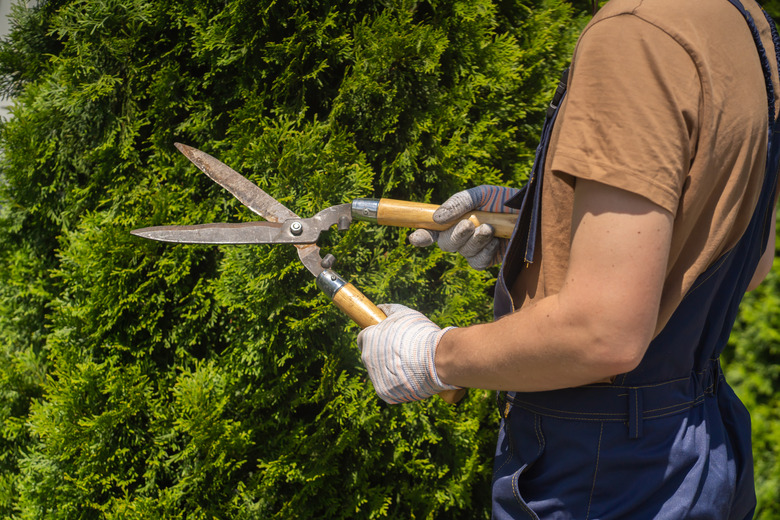How To Trim An Overgrown Arborvitae
We may receive a commission on purchases made from links.
Arborvitaes (Thuja spp.) are typical conifers in that they only grow from new growth. This means that trimming will not stimulate new growth, and if you prune off too much growth, your tree could end up permanently scarred or could even die. Don't let this knowledge scare you into avoiding making any cuts to keep the plants from looking shaggy. Just remember that you need to plan before you cut and then go slowly and carefully to avoid overpruning these beautiful evergreen trees.
When to Prune
When to Prune
If you plan on trimming healthy branches, try to time your pruning for just before the new growth comes in around the end of spring and beginning of summer. As a general rule, do not cut back more than one-third of the healthy foliage in any given season and do not cut more than a foot from any branch at a time.
How to Prune
How to Prune
When cutting off part of a branch, do not cut it back too far or it will fail to grow back. Only cut off the green portions of the branch, as the brown portions are old wood that cannot generate new growth. To check if the wood is green, scratch the bark with your fingernail to see the color underneath the surface.
Work in small sections at a time to avoid making mistakes that can damage the tree's appearance. Focus on trimming back vertical branches that shade lower parts of the tree, which slows growth in those areas. You may also want to remove vertical branches in the middle of the tree to allow more sunlight to enter and to improve air circulation, which can help keep trees healthier and reduce the risk of disease.
Dead, Damaged, and Diseased Branches
Dead, Damaged, and Diseased Branches
While it's a good idea to plan maintenance pruning for late spring or early summer, you may also need to periodically trim off damaged, diseased, dead, or errant branches, and these types of cuts can be done at any time. In fact, trimming diseased or damaged branches can reduce the risk of disease to the rest of the tree.
When removing whole branches, cut them off as close to the trunk as possible. Remove the ends of diseased branches a little at a time just below the dead needles and keep cutting until there is green growth again. Severely diseased branches may need to be removed entirely. Always discard diseased branches in the trash and keep them away from your healthy plants.
Use the Right Tools
Use the Right Tools
For best results, use hand pruning shears for smaller branches under 1/2 inch thick, lopping shears for branches 1/2 to 1 inch thick, and a pruning or bow saw for any branches over 1 inch thick. Your tools should be kept sharp so they leave behind clean cuts, as ripped and torn branches are more likely to become diseased. To further help eliminate the risk of disease, always sterilize tools before and after pruning. One easy way to do this is to wipe or dip the blades in 70 percent or greater isopropyl or ethanol alcohol.
References
- Plant Addicts: Pruning Arborvitae
- Bustling Nest: Trimming Arborvitae – 7 Common Mistakes People Make
- Wisconsin Horticulture: Pruning Evergreens
- University of California Agriculture and Natural Resources: Plant Safely in Drought-Tolerant Landscapes: Thuja spp.
- University of Florida IFAS Gardening Solutions: Disinfecting Your Garden Tools
